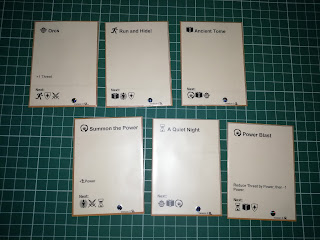I'm looking back at one of the games I mentioned a few weeks ago as possible targets for resurrection. This is currently a solitaire game (though it could become a co-op) with the working title of Monster Invasion. This is a project that first got going in late 2015, had its last serious bit of work in the summer of 2017, and then saw a little bit of poking in early 2021. As you can see, some of my projects can get dropped for a very long time.
The idea of the game is that your village is under attack from a horde of monsters. You play cards that represent the waves of monsters, the actions you take to fight them off, and the adventurers and strangers who might turn up to help you. Two quantities are tracked, "threat", which is represented by red counters in the picture above, and "power", which is the blue. Threat increases mostly when monsters arrive or when you need to draw an extra card to allow you to play, and can be decreased by fighting back or using magic. Power is your ability to use magic, and goes up and down as you take magical related actions or encounter certain monsters and visitors. If you get through the deck and manage to reduce the threat level to zero, you win. If the threat level reaches ten, you lose. Why ten? It's a number that seemed about right when I was doing the initial work on the game.
How the cards actually get played involves chaining icons together. Cards all have one or two icons in their top left corner (most have one) indicating the card type, and up to three icons at the bottom. When you play a card, the next card you play must have a card type matching one of the icons at the bottom of the card you just played.
By way of example...
In the picture above, we start off with the arrival of some Orcs. That has a running person icon at the bottom, so we are able to play the Run and Hide! card. This card in turn has a book icon, which means that while we are hiding, we can find an Ancient Tome and do some research in order to raise our power level via the Summon the Power card we are able to play next. That gives us a sandtimer icon, which allows us to have A Quiet Night, after which we are well enough rested to fire off a Power Blast that reduces the threat level.
This all actually worked pretty OK, and gave me a fairly fun way of spending 10 minutes or so. While something like this can be really lifted by nice presentation, and well-directed art could really help suggest a developing narrative in your battle, the game as it stood probably wouldn't engage most people for very long, and it really needs to do that without an investment in art.
The last couple of iterations of the game were toying with the idea of boss monsters, one or two of which could be added to the game, possibly seeding them into certain parts of the deck. The boss monsters could potentially have special effects that shape the way you approach playing the game, perhaps making certain actions you can take more or less effective. Boss cards might just be like the other cards in most respects, or they could stick around as modifiers until you find a way to get rid of them. I built versions of the prototype with a selection of bosses, but tests so far have resulted in lacklustre effects, though I was only using them as "normal" cards other than you having to play them as soon as you draw them.
Another issue is that sometimes you can just be caught for ages without drawing a playable card, building up threat as you keep drawing more cards, looking for something that won't get you killed. In some cases this happens due to a bad decision, but it can also just be that you draw eight times in a row and get nothing. This is bad, and may be fixable by tweaking the icons present on cards, or it may require some sort of special action like being able to play any card regardless of the continuity of icons. It may just be as simple as having too many different icons.
I think that, having had a bit of a play with this again, I want to have a bit more of a play to see if I can make this game a bit more solid and reliable. As a result I spent a little bit of time putting together a set on Screentop.gg, with a playmat that helps organise the components and make playing a little easier. I far prefer playing a game like this (as with most games) with physical cards, but once the basics are in place, I'll be able to iterate over this far more quickly, and will be able to share it with other folk who might be interested in taking a look.



No comments:
Post a Comment